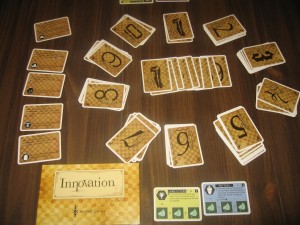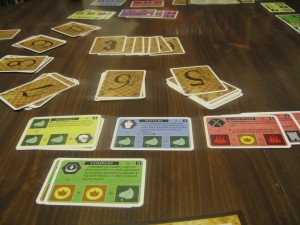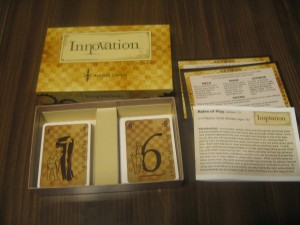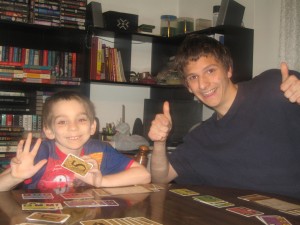Have you ever played Civilization, be it the video game or the board game? If you have, then you’d be familiar with the concept of a ”tech tree.” If you haven’t played any sort of game where you’re leveling up your civilization, then imagine a giant tree and at the bottom of said tree are the technologies that start your civilization off…things like “writing” and “the wheel.” As you go up the tree, you advance in technology, unlocking things like “bronze working” and eventually things like “rocketry.” The tree branches out into different areas of tech, covering different aspects of a civilization like the military and economy.
Innovation, as best as I can describe it, is Civilization: The Tech Tree Card Game, sort of. The game consists of cards ranging from ages / techs one through ten, the number is clearly written on the back of the card. On the face of the card is a specific technology like “the wheel” and various icons and actions that affect gameplay.
Players will be drawing cards from these ages starting with the smallest one first (age one) and gradually start working their way up. Their main goal is to score points and achievements. A player wins if they reach the number of achievements required (the number varies based on the number of players) or as indicated by a card that they might draw in the later ages.

In the middle of the circle are the achievement cards, ranging from 1-9. The ten ages players draw from form a circle around the achievements. Off to the left are special achievements awarded to a player upon completing a set of special conditions.
A card has actions on them accompanied by an icon, along with icons that run along the bottom and left side of the card. These icons are counted when determining whether or not a player can share in an action or during an “I demand” action by another player.
Besides the cards players hold in their hand, they form a playing area in front of them which houses piles of cards that have been played. Each pile has its own color, up to five piles, representing the different aspects of a civilization. When placing a card onto its colored pile (called “melding”), it goes on top (unless otherwise indicated), replacing the previous card and its available actions. Some cards allow you to shift your colored cards either up, down, left, or right so that the icons on the cards underneath are visible. This is called “splaying.”

An example of the play area. Each card has different icons on it. The more you have of a particular icon, the better chance you have in resisting or sharing in another player’s action. In this example, red is “splayed” to the left, allowing all of the icons on the right from the cards underneath to be visible.
On a player’s turn, they get to perform two actions from the following list:
1) Play (meld) a card from your hand onto one of your colored piles.
2) Pick up a card (draw) from the appropriate age. The age you can draw from is based on the top cards in your play area. Whatever the highest age card is in your play area is becomes the age you are able to draw from.
3) Claim an achievement (achieve). A number of conditions must be satisfied to claim an achievement.
4) Perform an action on a card (dogma). This is the very heart of the game as all of the cards have various abilities. Some allow you to shift or “splay” your cards in a direction making more icons visible (making you more powerful), some cards allow you to score cards / points which is key to claiming achievements, and other things that can affect other players.
I won’t go into the rules in detail, those interested would do well to Google the PDF of the instruction manual so that they can see all of the odd terms and game mechanics that the game offers.
At first, I have to admit that I was intimidated by this game, even though it was simply just a deck of playing cards. There were so many cards, each with their own actions on them…it got to the point where some cards made me pause for a minute so that I could try to figure out their effects. Once players overcome the hurdle of understanding the game terms and mechanics, the game will play out smoothly.
Vinnie Jr, the eleven year old, had the toughest time understanding what each of the cards did. He often didn’t know what the best move was because he didn’t understand half of the cards. He still enjoyed playing the game, but if you are trying to teach this game to beginners or younger kids, you’ll need to be patient and make sure you clear your afternoon. To be fair, the game DOES say that the recommended age is fourteen and up…though I still think that Vinnie Jr can get used to it if given the right amount of help and patience. Readers, keep in mind, I’m not bashing the game for having complex cards…I’m simply advising you to be patient with beginners and younger kids.
An hour into the game, we managed to get up to age four. I’m sure as we continue to play the game over and over again, we’ll get used to what all of the cards do and play will be much quicker. That concept is similar to that of any card game like Magic: The Gathering or Wiz-War in that there is a learning curve on what all of the card possibilities are.
Overall, the game was fun. We were constantly comparing icons to see who could share in what actions, so be prepared for a little math. For the first half hour, it was pretty chaotic.
Would I recommend it? That depends. Are you someone who isn’t intimidated by reading and interpreting a plethora of card actions? Are you willing to be patient with those who are having a hard time understanding certain concepts? Do you play complex card games often? If the answer is yes to most of these questions, then yes, I’d recommend it.
Final Verdict: 6/10


